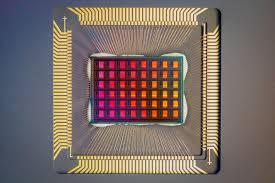Neuromorphic Chip Market Pain Points Hindering Large-Scale Commercial Adoption Worldwide
The neuromorphic chip market holds significant promise for transforming AI, edge computing, and intelligent systems by replicating the brain's neural network functions in hardware. However, despite technological advancements and growing interest, the market faces several pain points that are hindering large-scale commercial deployment. These challenges range from technical limitations and production costs to ecosystem readiness and application barriers, creating hurdles for manufacturers, researchers, and potential adopters alike.
Understanding these pain points is crucial for stakeholders aiming to unlock the full potential of neuromorphic computing in industries such as healthcare, robotics, automotive, and consumer electronics.

Key Pain Points in the Neuromorphic Chip Market
1. High Development and Production Costs
One of the most significant barriers to the neuromorphic chip market's growth is the high development and manufacturing costs associated with these advanced processors. Neuromorphic chips often require specialized materials such as memristors or spintronic devices, along with complex fabrication processes that differ from conventional semiconductor manufacturing.
The lack of established mass production capabilities for neuromorphic hardware results in limited economies of scale, keeping costs high and restricting accessibility to niche research and prototype projects. For the market to mature, significant investment is required to scale production, reduce costs, and make these chips commercially viable for widespread use.
2. Limited Commercially Ready Applications
Despite the theoretical advantages of neuromorphic chips, the market currently suffers from a lack of commercially proven, large-scale applications. Most neuromorphic computing projects remain confined to academic research, pilot programs, or highly specialized use cases in defense or experimental robotics.
This lack of proven real-world deployments creates skepticism among potential adopters and investors. Without clear demonstrations of scalable, cost-effective, and reliable neuromorphic solutions, industries remain hesitant to integrate these chips into mainstream products, slowing market adoption.
3. Immature Software Ecosystem and Programming Complexity
A major pain point for developers is the immature software ecosystem surrounding neuromorphic chips. Unlike traditional CPUs and GPUs that benefit from decades of robust development tools, programming models for neuromorphic processors are still evolving.
Designing algorithms that leverage brain-inspired architectures requires specialized knowledge in neuroscience, computational modeling, and hardware-software co-design. This steep learning curve and the absence of standardized development frameworks create bottlenecks in application development and hinder broader market participation.
4. Integration Challenges with Existing AI Infrastructure
Neuromorphic chips are fundamentally different from conventional computing architectures, making integration with existing AI systems, cloud platforms, and data centers challenging. Most AI workloads today are optimized for CPUs, GPUs, or AI accelerators like TPUs.
Introducing neuromorphic chips into these environments requires substantial re-engineering of software, algorithms, and hardware interfaces. The time, cost, and expertise needed for seamless integration discourage many organizations from experimenting with neuromorphic solutions, further delaying their adoption.
5. Scalability and Manufacturing Bottlenecks
Scalability remains a significant pain point for the neuromorphic chip market. Current neuromorphic prototypes often demonstrate impressive results in small-scale, controlled environments. However, scaling these designs to support mass-market products while maintaining performance, reliability, and cost efficiency is a major technical hurdle.
Additionally, many neuromorphic designs rely on experimental materials or architectures that have yet to prove their scalability for large-volume production. Overcoming these bottlenecks is essential to transitioning from research and development to mass-market availability.
6. Unclear Regulatory and Standardization Landscape
The lack of clear regulatory frameworks and industry standards for neuromorphic chips presents another barrier to market growth. With applications spanning sensitive sectors such as defense, healthcare, and autonomous vehicles, regulatory clarity is vital for safety, security, and interoperability.
The absence of universally accepted standards slows down collaboration, increases compliance uncertainties, and hampers cross-industry adoption efforts. Market participants require guidance from standard-setting bodies and regulators to ensure neuromorphic technologies meet necessary performance, safety, and ethical criteria.
7. Market Education and Awareness Gaps
Despite growing media attention, many potential end-users, investors, and decision-makers still lack a clear understanding of what neuromorphic chips are and how they differ from traditional AI hardware. This education gap fuels misconceptions, unrealistic expectations, or outright resistance to exploring neuromorphic solutions.
Bridging this awareness gap through targeted education, industry partnerships, and pilot demonstrations is critical for building confidence and driving broader acceptance of neuromorphic technologies across different sectors.
Conclusion
While the neuromorphic chip market offers tremendous potential to revolutionize AI, computing, and intelligent systems, several pain points continue to slow its path to mainstream adoption. High production costs, limited real-world applications, complex programming requirements, and integration challenges remain key hurdles. Overcoming these barriers will require coordinated efforts from researchers, manufacturers, regulators, and industry stakeholders. As solutions to these pain points emerge, neuromorphic chips could become a foundational technology for the next generation of energy-efficient, adaptive, and brain-inspired computing systems.
- Art
- Causes
- Crafts
- Dance
- Drinks
- Film
- Fitness
- Food
- Games
- Gardening
- Health
- Home
- Literature
- Music
- Networking
- Other
- Party
- Religion
- Shopping
- Sports
- Theater
- Wellness


